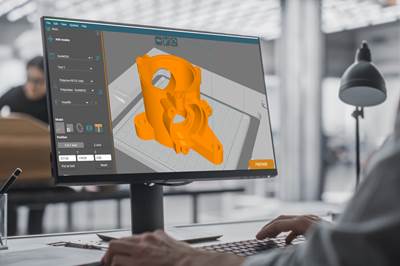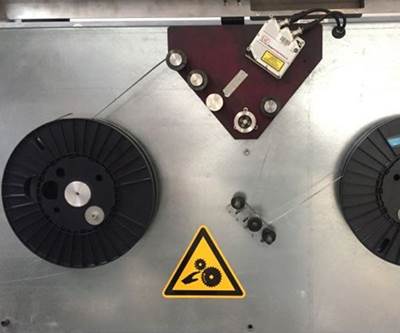AIM3D announces Voxelfill resolves inhomogeneous strength of 3D printing
Validation of 80-100% tensile strength and comparability to injection molding via Voxelfill extrusion process was achieved through plastic and fiber-filled test series.
Comparison of Voxelfill and conventional 3D printing based on a printed bracket. Source (All Images) | AIM3D
AIM3D GmbH (Rostock, Germany) announces that it has succeeded in demonstrating the advantages of its patented Voxelfill process, a 3D printing technique that improves the strength and elasticity of plastic and fiber-filled plastic components by creating a lattice structure of voxels to be filled with thermoplastic material. AIM3D contends that strength tests prove the process’ ability to overcome inhomogeneous strengths of 3D components in X, Y and Z axes, thus coming close to conventional processes such as injection molding. Furthermore, Voxelfill can be licensed to users of other 3D printing processes for material extrusion in accordance with EP 4100235-B1.
When 3D printing polymers, components usually end up with inhomogeneous strength properties due to the layer-based build process. This manifests itself primarily in the form of shortcomings in tensile and flexural strength, as well as very brittle behavior along the Z-axis. In contrast, some processes achieve strengths along the X and Y axes that already come close to the strengths obtained with conventional injection molding. Previously, AIM3D has successfully demonstrated this with the processing of fiber-filled components based on PA6 GF30 and pure thermoplastics such as Ultem 9085. Nevertheless, the company notes that the phenomenon of inhomogeneous strength properties needs to be resolved to enable a wide applicability of 3D printed components.
Via CEM extrusion, AIM3D has developed a Voxelfill strategy that overcomes these limitations and increases the cost-effectiveness of the CEM process. Voxelfill can also be used for multi-material components and is generally suitable for constructing 3D components using plastics, metals and ceramics. “With Voxelfill, users can now improve Z-strength and printing speed,” says Clemens Lieberwirth, CTO of AIM3D. “We are consistently developing this technology further.”
Currently, material extrusion 3D printing achieves approximately 50% tensile strength in the direction of printing, depending on the material. The printed layers therefore tear apart, often making components only suitable for prototypes. With Voxelfill, AIM3D now achieves 80% tensile strength compared to the mold-bound injection molding process, enabling the technical application of 3D printed parts made from certified pellets. The potential target is to achieve 100% tensile strength.
Moreover, in the XY plane, Voxelfill achieves mechanical strengths of 80% compared to injection molding; the initially determined values apply to unfilled technical polymers. This reportedly results in twice the strength compared to conventional 3D printing with fused deposition modeling (FDM) printers. For fiber-filled polymers, the expected increase in strength compared to conventional 3D printing with FDM printers is even higher.
Figure 1. Comparison of tensile strength for unfilled plastic samples. Prone, upright (with Voxelfill) and upright (conventional).
To determine this, the Voxelfill-based test series were set up with tensile specimens to determine XY strength and Z strength (Fig. 1). Variant A were horizontal specimens to test the tensile strength in the XY plane. Variant B were upright specimens to test the tensile strength in the XZ plane. Variant C was a block to test the tensile strength in the XZ plane based on milled specimens. As part of the AIM3D feasibility study, the stress (MPa) and strain (%) were measured for variants A-C (material used was Polycore PETG-1000 from Polymaker, Shanghai, China).
Initial results: Comparison of strength and standard deviation in sample testing
Figure 2. Voxelfill reference with tensile specimens oriented in the XY-plane with measurement of stress (MPa) and strain (%).
Figure 3. Voxelfill reference with tensile specimens oriented in the XZ-plane with measurements of stress (MPa) and strain (%).
The results from initial testing indicate Voxelfill’s potential. Considering the results of the conventionally produced samples (layer by layer), it becomes apparent that anisotropy is the weak point of 3D printed components. The samples printed in an XY orientation (Variant A) show a ductile stress-strain curve, which is typical for an unfilled plastic. At 52.83 MPa, the tensile strength is even slightly higher than the value from the material data sheet (50 ±1.1 MPa) for injection molding. A comparison of the samples printed in a conventional manner in the XZ direction (Variants B and C) reveals deviations in the tensile strength and in the standard deviation. AIM3D says this results from the unfavorable geometry of an upright tensile specimen with respect to material extrusion 3D printing.
Higher standard deviation is a good indication that a stochastic effect, such as the vibration of the specimen, plays a major role here. However, a tensile test is a test in which geometric effects and notch effects should not have to be considered. For further analysis of the strength along the XZ construction direction, AIM3D focused on the samples that were milled from a vertically printed block. A comparison between the conventionally printed samples and the Voxelfill samples reveals that the use of Voxelfill results in twice the tensile strength — from 20 MPa for the conventionally printed samples to 40 MPa for the Voxelfill samples. In comparison, the strength of the horizontally printed samples was 53 MPa. In summary: The anisotropy amounts to 70% for the conventionally printed samples and only 23% for the Voxelfill samples.
Homogeneity, strength results based on fiber-filled test series
AIM3D also performed a series of tests to determine the optimum printing parameters using fiber-filled plastics, in order to compare the maximum achievable strength with conventional 3D printing and Voxelfill.
Tests were carried out with Polymaker’s PETG GF30 at an extrusion temperature of 270°C. Tensile specimens in horizontal XY-orientation were produced as a reference. These were printed with two different infill orientations: one along the tensile direction and another at ±45° to the tensile direction (Fig. 5).
Figure 5. Comparison of tensile strengths using fiber-filled plastics: prone 90°, prone ±45°, upright (with Voxelfill) and upright (conventional).
According to the company, tensile strength with the infill oriented in the tensile direction was the highest at 72.4 MPa. However, AIM3D believes that this corresponds to a fictitious case, as this would not occur in a real injection molded part, where the fiber distribution depends on the geometry of the part and the number and orientation of the injection points. In comparison, the horizontal tensile specimens with an infill orientation of ±45° achieved 50.1 MPa. Following this, upright tensile specimens were printed in a conventional manner using a layer-by-layer infill without Voxelfill (which corresponds to the status of normal 3D printers). These achieved a tensile strength of 12.8 MPa. In comparison, the upright test specimens printed using Voxelfill achieved a higher tensile strength of 40.7 MPa.
Comparing the determined values for the tensile strengths reveals a homogeneity of strength of 81% for Voxelfill compared to the ±45° printed reference specimens, and 56% compared to the aligned reference specimens. The conventionally printed tensile specimens, on the other hand, only achieved a homogeneity of 25% compared to the ±45° printed reference specimens ,and 18% compared to the aligned reference specimens. The strength-increasing effect of Voxelfill — which leads to more homogeneous component properties, comparable to those from injection molding — has therefore been demonstrated with fiber-filled plastics (see comparative diagram with the different tensile strength values). Moreover, a look at the fiber distribution under the confocal microscope (Fig. 6) shows fibers aligned in the Z-direction, which are introduced by Voxefill’s vertical injection process.
“We now believe more than ever in our CEM [composite extrusion modeling] technology and the established team at AIM3D,” says Lieberwirth. “3D pellet printers offer the option of cost-effectively mapping the properties of conventionally manufactured components with an additive manufacturing [AM] strategy. With Voxelfill, 3D printing now approaches the mechanical strengths of conventional injection molding.”
Related Content
Sulapac introduces Sulapac Flow 1.7 to replace PLA, ABS and PP in FDM, FGF
Available as filament and granules for extrusion, new wood composite matches properties yet is compostable, eliminates microplastics and reduces carbon footprint.
Read MoreA new era for ceramic matrix composites
CMC is expanding, with new fiber production in Europe, faster processes and higher temperature materials enabling applications for industry, hypersonics and New Space.
Read MoreJeep all-composite roof receivers achieve steel performance at low mass
Ultrashort carbon fiber/PPA replaces steel on rooftop brackets to hold Jeep soft tops, hardtops.
Read MorePEEK vs. PEKK vs. PAEK and continuous compression molding
Suppliers of thermoplastics and carbon fiber chime in regarding PEEK vs. PEKK, and now PAEK, as well as in-situ consolidation — the supply chain for thermoplastic tape composites continues to evolve.
Read MoreRead Next
Photothermal tomography for locating, quantifying defects in composites
Years of infrared testing development result in thermography technology that is no longer just qualitative, but can define defect size and depth, making additional UT scans obsolete.
Read MoreAIM3D's Voxelfill strategy is backed by slicing software SlicEx
New slicing plug-in from Create it Real for AIM3D’s Voxelfill technology to overcome inhomogeneous strengths and to achieve selective densities of 3D metal, fiber-filled plastic and ceramic components
Read MoreMeasuring thermoplastic prepreg tape quality for part process control
Low-cost tests measuring dimensions, thermal behavior and consolidation predict CFRTP part quality.
Read More



















.jpg;maxWidth=300;quality=90)










